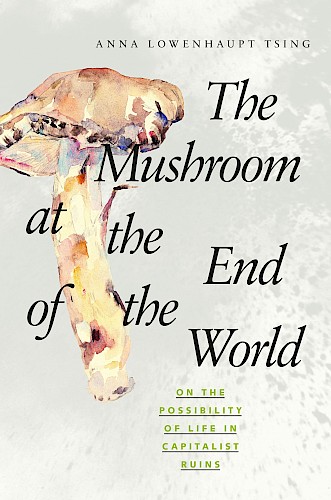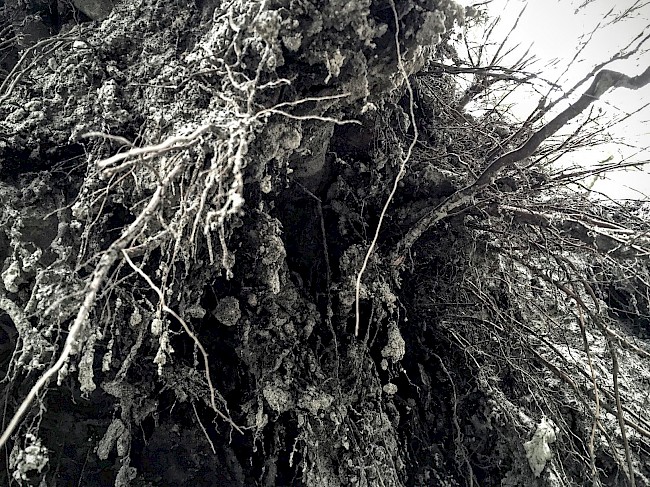Mushroom worlds and earth beings
A resurgence of postrepresentational anthropology
—
A review essay
Anna Lowenhaupt Tsing, The Mushroom at the End of the World: On the Possibility of Life in Capitalist Ruin. Princeton, NJ: Princeton University Press, 2015. Paperback, 331 pp. $29.95, £19.95. ISBN: 9780691162751.
Marisol de la Cadena, Earth Beings: Ecologies of Practice across Andean Worlds. Durham, NC: Duke University Press, 2015. Paperback, 340 pp. $26.95. ISBN: 9780822359630.
‘It matters what ideas we use to think other ideas with’. – Marilyn Strathern, Reproducing the Future (1992, 10)
Recent books by Anna Tsing and Marisol de la Cadena offer an occasion to celebrate the resurgence of postrepresentational anthropology. Where scientific representation seeks to map out singular truths, and political representation demands that sovereign bodies stand in for the bodies of others, postrepresentation does not abandon representation but enlarges its possibilities, going beyond reflecting facts to authorizing futures. These books push representation into the terrain of contaminated connections, where science need not be universal nor political subjects stable. While based on careful empiricism – photographs, poetry, drawings, narratives, and their interludes fill the two texts – this approach to representation also transforms the terms of the empirical. Precarity. History. Science. Politics. Evidence. Storytelling. Nothing is given; nothing is what it may have seemed to be.
Do you find a contradiction in the claim ‘resurgence of postrepresentational’? Does ‘resurgence’ resurrect the past, while ‘post’ implies a break from what came before? Reading Tsing, we might anticipate the accusation by pointing out that contradictions are the vibrant mess of vital being, a space where the otherwise flourishes. De la Cadena gives us a similar, though slightly adjusted, response: the designation ‘contradiction’ is itself trapped in modernist ordering, predicated upon a false homogeneity of time. There is, after all, no contradiction at all if you do not expect life to move linearly, if development is not progressive, and if chronology is ahistorical. New! Novel! Innovative! These words, with their capitalist/modernist promise of a better tomorrow, are not the right ones to describe what these authors are up to. Instead, the imaginings they cultivate make it possible to notice in the here-and-now what may have been with us all along.
The Mushroom at the End of the World is a book on the move. Oregon. Japan. Finland. China. Laos. And diverse geographies are just part of it. The sites that form the basis of Tsing’s account of the social life of the matsutake mushroom are so diffuse that ‘multisited’ ethnography – a plurality of numerable sites – hardly seems fitting. We are amidst tracers and traders, in and out of times, mixed up in global economies and peasant woodlands. This is a book without teleology, whose ‘rush of troubled stories’ (p. 34) is at once method and finding.
A warning to the reader: do not come to this text for direct engagement with big theory or big theorists. An exception is a brief section that cites debates between Gibson-Graham and Hardt and Negri; it argues that rather than cleave capitalism from its others, we can learn about capitalism through ethnographic study of the noncapitalist elements upon which capitalism depends. Mostly, however, Tsing focuses on fieldwork, organizing stories around the activities of her research informants and collaborators, saving theoretical debate for another place.
This is not to say that there are not several firm, compelling arguments. The book is premised on the idea that by paying attention to a neglected commodity chain, we can learn much about abrupt – and global – change. And, indeed, careful analysis of the matsutake and its handlers allows her to outline several transformations: in American assimilation projects (to be American you must convert, but to democracy not Christianity); in global capitalism (salvage accumulation, pericapitalism, and supply-chain contracting have grown together, turning capitalism’s traditional forms on their head); and in conditions of precarity (rather than seek to eliminate disturbance we might work to make life flourish within it).
Yet, despite the importance of these broader provocations, what comes through most clearly to me is the urgency of cultivating what she calls ‘arts of noticing’, the capacity to attend to that which is, like matsutake in the forest, slightly hidden, forgotten, or otherwise hard to see. The desired ends of this kind of noticing do not fit well with grand narratives (such as the heroic call to ‘save the world’), but are better suited for engaging with mundane pleasures and challenges, for example, of the meal at hand or a walk through the woods. She likens this to the skill of listening to polyphonic music, a musical form based in autonomous melodies. This is difficult music to listen to for those accustomed to unified rhythms and harmony – music with ‘a single perspective’, like that found in the strong beat of rock and roll (p. 23). Aligned with the ability to listen carefully to unfamiliar music, the book works passionately to help its readers appreciate spaces of dissonance. After all, the gift of this ugly, smelly treasure of a mushroom whose production cannot be scaled up is that it thrives in difficult sites.
De la Cadena’s Earth Beings reads, from start to finish, as a labor of love. This book of stories about stories is based on the lives of Mariano and Nazario Turpo, a father and son from the Peruvian community of Pacchanta; the earth-being Ausangate; and the anthropological project of translation. Mariano and Nazario are today generally recognized (at least by anthropologists) as political actors. Ausangate’s place as a political actor still remains largely foreclosed.
De la Cadena offers a careful history of the Turpos’ journey through Peruvian politics (complete with timelines) that never loses sight of the politics of history’s possibilities. The argument that emerges most forcefully through this much-needed Latin Americanization of Latour’s ‘modern constitution’ is this: postcolonial theory has still not adequately decolonized the modernist division between nature and humanity, reinforcing the ‘coloniality of history’ in its admission of only certain kinds of evidence into the terrain of the real. It is not just enough to bring the other-than-human into regimes of reality; to push beyond the violence of the archival time and space of the modern state, we must make room for the eventfulness of the ahistorical and the possibility that evidence is not a precondition of reality.
How unfair it is of me to distill this rich text in this way! Each page is dense with insights about the intricacies and challenges of collaborative politics. Arturo Escobar writes on the back cover that De la Cadena helps to crystallize current debates and rearticulate them in new ways. This is not overstated. There is thorough engagement with feminist and postcolonial thinkers throughout: Strathern and Haraway on the fractal cyborgs of relationality, Viveiros de Castro on perspectivism, Trouillot on the conditions of the unthinkable, Chakrabarty on historical time, Star and Griesemer on boundary objects, Stengers on ecologies of practice, and so on.
A lesson that lingers: translation should not aim for mutual understanding but for ‘controlled equivocation’, a term used by Viveiros de Castro in his critique of the imperialist presumption of the possibility of knowing the world in another’s terms. Controlled equivocations do not seek faithful translations, but rather probe translation practices to make the conjuncture evident. (Notably, the text is filled with Quechua and Spanish terms with few literal translations, forcing the reader to, at very least, slow down. I finished reading with a promise to myself that I would never again simplistically translate from term to term.) The quest to understand belief, meaning, knowledge, and perspective – in short, the focus of twentieth-century anthropology – may unwittingly (or not) reinforce the very modernist conventions that it has sought to challenge. In this vein, the book makes it clear that the languages that we have to talk about similarity and difference are still ensnared in colonial taxonomies. Radical difference (p. 275) does not preclude the constitutive ‘intra-relations’ through which entities such as Indigenous and non-Indigenous become intelligible; it rather makes apparent that there are many ways of making coherence and division.
Given that both texts are inspired by Strathern throughout, it is fitting that I have an opportunity to juxtapose them here, forcing a conversation for the sake of comparing the strategies at work (and play). There are several similarities in their organization: They share an approach to feminism whose commitment is less to the category ‘woman’ than to challenging academic conventions about how subjects and objects are made. They seek to undo existing cartographies of space and time, each asking how to think about justice (social and otherwise) without depending upon narratives of progress. And they manage to carry joy – and even laughter – through the pages while not losing sight of violence and exploitation.
Still, a difference in where the texts end is so striking that it deserves attention. For while Tsing calls to overturn capitalism through the ‘latent commons’, forming entanglements that can be mobilized for a common cause (p. 134) and common agendas (p. 254), De la Cadena is in search of an alterpolitics that does not just refuse, but, far more heretically, ignores calls for unity. She is after a postplural politics that aims for controlled equivocation, a politics where there is no intention to be one. The mushroom that we find amid Tsing’s patchy assemblages may burst categories and upend identities. But entanglement still resides within a language of expansion, leaving readers, at least at times, in the uncomfortably modernist project of tracking and tracing material evidence of an object that proliferates through an also still-singular world.
I cannot help but notice an interesting similarity that emerges in this divergence. For even as I feel discomfort with the imperial risks implicit in the project of tracing ‘the world’ and its commons, I am reminded by both Tsing and De la Cadena of the generative place of disconcertment. Would it be better if, while holding an academic position and writing reviews of written texts for academic journals (albeit of the creative, open-access sort), I felt that I were valiantly escaping the strictures of modernism?
This is the generative puzzlement of postrepresentational anthropology: we do not get outside of writing while writing, and still the insides and outsides of writing are not everywhere the same. The unit of ‘the unit’ remains, after all, ontologically variable: sometimes self-contained and sometimes, as in the case of the unit of anthropological classification, reliant on a frame ‘that must be continually broken to retain its use’ (Tsing, p. 231). Even the unity of commonality may not be what it seems. When temporality is unsettled from linear (hegemonic) models of cause and effect, it becomes possible to be one and not one, different and connected. To long for the purity of the prose of Mariano’s in-ayllu (in which there is no separation between event and its narration, signifier and sign) is to long for the impossibility of the perfect, stable translation. Meanwhile failure of translation may not be a failure at all, for our stories can – and do – shape the worlds they bring into being and the directions that transformations can take.
In the case of these two texts, their stories have carried me to the possibilities of new questions. In the spirit of Tsing’s anti-ending, I close with a few of them:
What is the landscape of non-holist ecology?
How can we build vocabularies for difference and division that do not rely on the cut of the dichotomy?
How can we push the ontological partiality of representation in ways that help shape inhabitable worlds for collectives both visible and invisible?
What kinds of old beginnings can we remake anew?
About the author
Emily Yates-Doerr is Assistant Professor of Anthropology at the University of Amsterdam. The review was written from Guatemala, where she is learning about efforts to improve global development by improving fetal development, the co-constitution of emergency and chronicity, and incompossible togetherness. http://www.uva.nl/profile/e.j.f.yates-doerrhttp://whatiseating.com
Reference
Strathern, Marilyn. 1992. Reproducing the Future: Essays on Anthropology, Kinship, and the New Reproductive Technologies. New York: Routledge.





